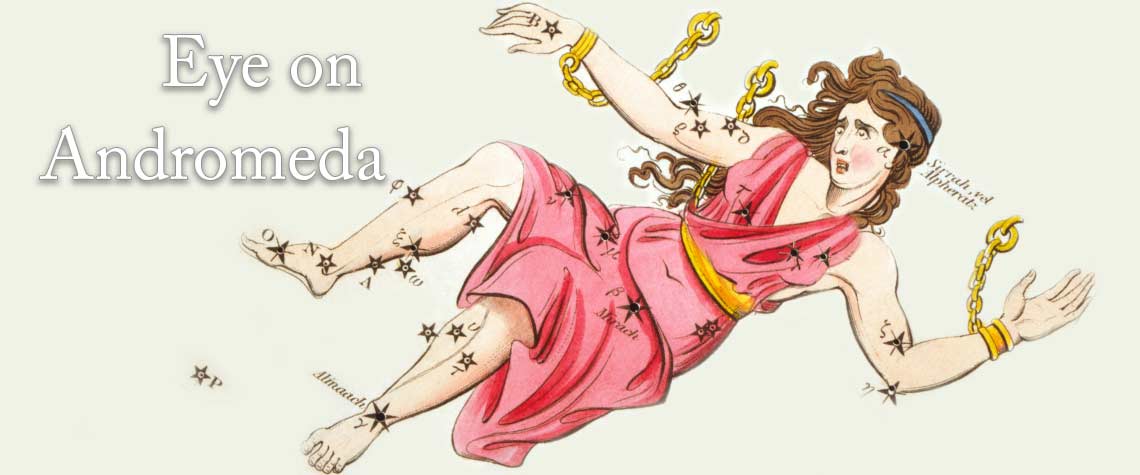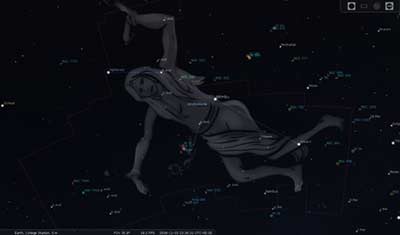Page 5


Observing the Fall Sky - Andromeda
By Tom Campbell
Andromeda was the daughter of King Cepheus and Queen Cassiopeia of Ethiopia. Cassiopeia was very beautiful, but also prideful and one day boasted that she was even prettier than the water nymphs. This upset Poseidon, so he created a sea monster named Cetus to devour people and animals in the land. After consulting the oracle of Ammon to see how to rid his kingdom of the monster, the king was sorrowful to learn that the only way to defeat the creature was to sacrifice his daughter to it.
Not wanting to see his people terrorized any more, the king reluctantly agreed. He chained Andromeda to a large rock at the edge of the sea. However, the hero Perseus came by on his flying horse Pegasus about this time and offered to rescue the princess on the condition that she marry him. The king readily agreed.
Perseus told Andromeda to close her eyes tightly and not open them again until he said so. She did as he asked and when Cetus approached them, he reached into his bag and pulled out Medusa's head. The monster immediately turned into a giant stone upon looking at the Medusan face and it can still be seen to this day on the Levantine shore of the Mediterranean.
Perseus put Medusa's head back in his bag and tied it shut, then unchained Andromeda. The grateful king wed the two immediately and they flew off on Pegasus to live in Argos.
This story is well-represented in the night sky. Cepheus, Cassiopeia, Andromeda, Perseus, Pegasus and even Cetus have their own constellations. In the sky, the "head" of Andromeda (Alpheratz) is actually one of the four bright stars comprising the Great Square of Pegasus.
The constellation of Andromeda contains many delights, including one of the most well-known galaxies. Messier 31, also known as the Andromeda Galaxy, is large and even visible with the unaided eye in dark skies. This spiral galaxy is about twice as large as our own Milky Way, containing approximately one trillion stars. It is a member of our Local Group of galaxies, being the closest large galaxy to us. Our two galaxies are moving towards each other and will merge in another 4.5 billion years or so.
Messier 32 is a satellite galaxy of M31 and can be seen in the same field. It is a dwarf elliptical galaxy and appears as a bright fuzzy patch not too far away from the core of M31.
Messier 110 is another nearby satellite of M31. Although Charles Messier never specifically included this galaxy in his famous list, it was depicted by him (along with M32) on a drawing he made of the Andromeda Galaxy in 1773. The galaxy was independently discovered ten years later by Caroline Herschel, the sister of astronomer William Herschel. In 1967, Kenneth Glyn Jones made the suggestion to assign this galaxy a Messier number and it has been known as M110 ever since.
Gamma (γ) Andromedae, also known as Almach, is the third brightest star in the constellation. It is a multiple star system located about 355 light years from Earth. The main star is a bright golden-yellow and the fainter companion is blue. At high magnification, the blue star can itself be split into two stars, and one of those stars is also a spectroscopic binary with a fourth star.
Pi (π) Andromedae is a pretty multiple star system. The bright primary is a blue giant with a spectroscopic double. The secondary component is easily split although it is a lot fainter. A third possible companion lies in the opposite direction and is even fainter.
NGC 404 (Mirach's Ghost) is a fun little galaxy to find. It lies very close to the bright star Mirach (β And) which makes it more difficult to see. The fact that it's a faint round elliptical galaxy makes it actually appear like a lens flare from Mirach until you notice that it maintains its position among the stars even as you jiggle the eyepiece.
NGC 7662 (Blue Snowball) is a planetary nebula about 2,000 to 4,000 light years away with a faint central star that varies between magnitudes 12-14. A small telescope will reveal a fuzzy looking star with a bluish cast, while 16-inch or better telescopes can reveal color and brightness variations in the interior.
NGC 891 is an edge-on spiral galaxy about 30 million light years away. Nicknamed the Silver Sliver, astronomers believe it looks a lot like the Milky Way would look if seen at a similar angle. In 2005, NGC 891 was selected to be the first light image of the Large Binocular Telescope and in 2012, it was selected as the first light image for the Discovery Channel Telescope.
| Object | Type | Mag(s) | Dist. (ly) | R. A. | Dec. |
|---|---|---|---|---|---|
| Messier 31 | Spiral Galaxy | 3.4 | 2.5 million | 00h 42.7m | +41° 16' |
| Messier 32 | Elliptical Galaxy | 8.1 | 2.5 million | 00h 42.7m | +40° 52' |
| Messier 110 | Elliptical Galaxy | 8.1 | 2.7 million | 00h 40.4m | +41° 41' |
| γ And (Almach) | Multiple Star | 2.3, 5.0 | 355 | 02h 03.9m | +42° 20' |
| π And | Double Star | 4.3, 7.1 | 598 | 00h 36.9m | +33° 43' |
| NGC 404 (Mirach's Ghost) | Active Galaxy | 11.7 | 10 million | 01h 09.5m | +35° 43' |
| NGC 7662 (Blue Snowball) | Planetary Nebula | 8.3 | 6400 | 23h 25.9m | +42° 32' |
| NGC 891 | Spiral Galaxy | 10.1 | 29.7 million | 02h 22.5m | +42° 21' |

